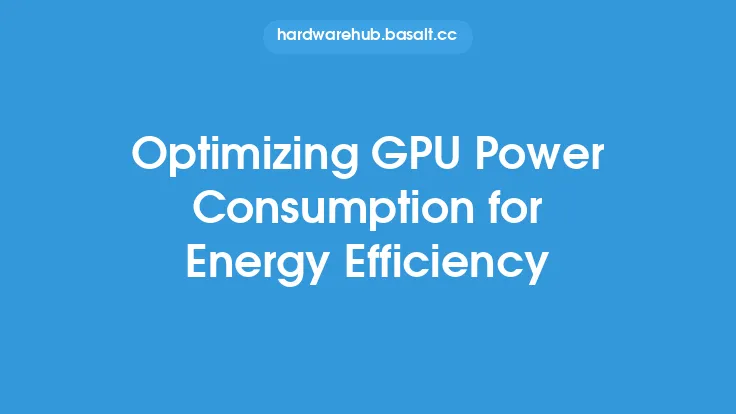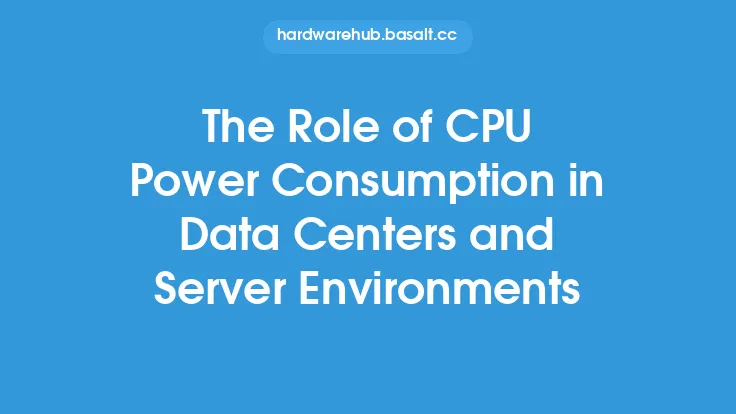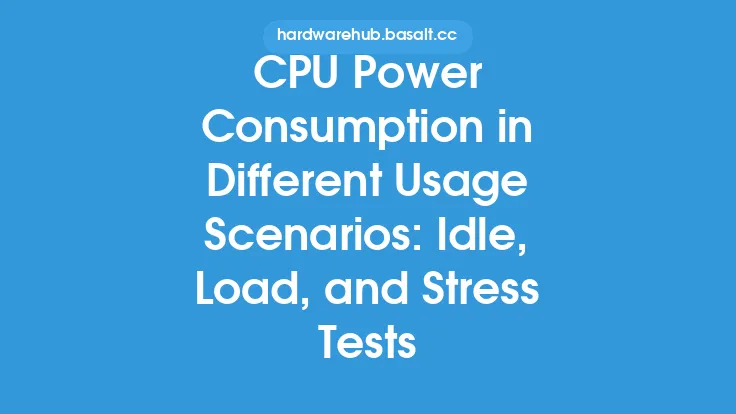The power consumption of a Central Processing Unit (CPU) is a critical aspect of computer architecture, as it directly affects the overall energy efficiency, heat generation, and performance of a system. Several factors influence the power consumption of a CPU, and understanding these factors is essential for designing and building energy-efficient computing systems. In this article, we will delve into the key factors that affect CPU power consumption, exploring the technical aspects and their implications on energy efficiency.
Introduction to CPU Power Consumption
CPU power consumption refers to the amount of electrical power required to operate a CPU. This power is used to perform various tasks, such as executing instructions, accessing memory, and communicating with other system components. The power consumption of a CPU is typically measured in watts (W) or milliwatts (mW). Modern CPUs are designed to minimize power consumption while maintaining high performance, as excessive power consumption can lead to increased heat generation, reduced battery life, and higher energy costs.
Factors Influencing CPU Power Consumption
Several factors contribute to the power consumption of a CPU, including:
- Clock Speed: The clock speed of a CPU, measured in gigahertz (GHz), directly affects its power consumption. Higher clock speeds result in increased power consumption, as the CPU requires more energy to switch transistors and perform calculations at a faster rate.
- Number of Cores: Multi-core CPUs, which integrate multiple processing cores on a single die, generally consume more power than single-core CPUs. However, the power consumption per core can be lower in multi-core designs, making them more energy-efficient for certain workloads.
- Transistor Density: The density of transistors on a CPU die affects its power consumption. As transistors are packed more closely together, the CPU requires more power to operate, due to increased leakage current and switching energy.
- Voltage: The operating voltage of a CPU, typically measured in volts (V), has a significant impact on its power consumption. Lower voltage levels can reduce power consumption, but may also affect performance, as the CPU requires a minimum voltage to operate reliably.
- Cache Memory: The size and organization of cache memory can influence CPU power consumption. Larger caches can reduce the number of main memory accesses, resulting in lower power consumption, but may also increase the CPU's overall power consumption due to the additional transistors and wiring required.
CPU Architecture and Power Consumption
The architecture of a CPU plays a crucial role in determining its power consumption. Different CPU architectures, such as x86, ARM, and MIPS, have distinct power consumption characteristics. For example:
- x86 Architecture: x86 CPUs, commonly used in desktop and laptop computers, tend to consume more power than other architectures, due to their complex instruction set and high clock speeds.
- ARM Architecture: ARM CPUs, widely used in mobile devices and embedded systems, are designed for low power consumption and often feature clock gating, power gating, and dynamic voltage and frequency scaling (DVFS) to minimize energy usage.
- MIPS Architecture: MIPS CPUs, used in various embedded systems and networking equipment, offer a balance between performance and power consumption, with some implementations featuring low-power modes and clock throttling.
Manufacturing Process and Power Consumption
The manufacturing process used to fabricate a CPU can significantly impact its power consumption. Advances in semiconductor manufacturing, such as:
- FinFET Transistors: FinFET (fin field-effect transistor) technology, used in modern CPUs, provides improved leakage current control and reduced power consumption compared to traditional planar transistors.
- 3D Stacked Integration: 3D stacked integration, which stacks multiple layers of transistors and interconnects, can reduce power consumption by minimizing wire lengths and increasing transistor density.
- Die Shrinking: Die shrinking, the process of reducing the size of a CPU die, can lead to lower power consumption, as fewer transistors are required to achieve the same performance.
Power Management Techniques
To mitigate the effects of high power consumption, CPU manufacturers employ various power management techniques, including:
- Dynamic Voltage and Frequency Scaling (DVFS): DVFS adjusts the operating voltage and clock speed of a CPU based on workload demands, reducing power consumption during periods of low activity.
- Clock Gating: Clock gating disables the clock signal to idle components, eliminating unnecessary power consumption.
- Power Gating: Power gating completely powers down idle components, reducing leakage current and standby power consumption.
- Sleep Modes: Sleep modes, such as C-states (e.g., C0, C1, C2, etc.), put the CPU into a low-power state, reducing power consumption during periods of inactivity.
Conclusion
In conclusion, CPU power consumption is influenced by a complex interplay of factors, including clock speed, number of cores, transistor density, voltage, cache memory, CPU architecture, manufacturing process, and power management techniques. Understanding these factors is essential for designing and building energy-efficient computing systems. As the demand for high-performance, low-power CPUs continues to grow, manufacturers must balance performance, power consumption, and heat generation to create efficient and reliable computing systems. By exploring the technical aspects of CPU power consumption, we can better appreciate the challenges and opportunities in creating energy-efficient computing solutions.





